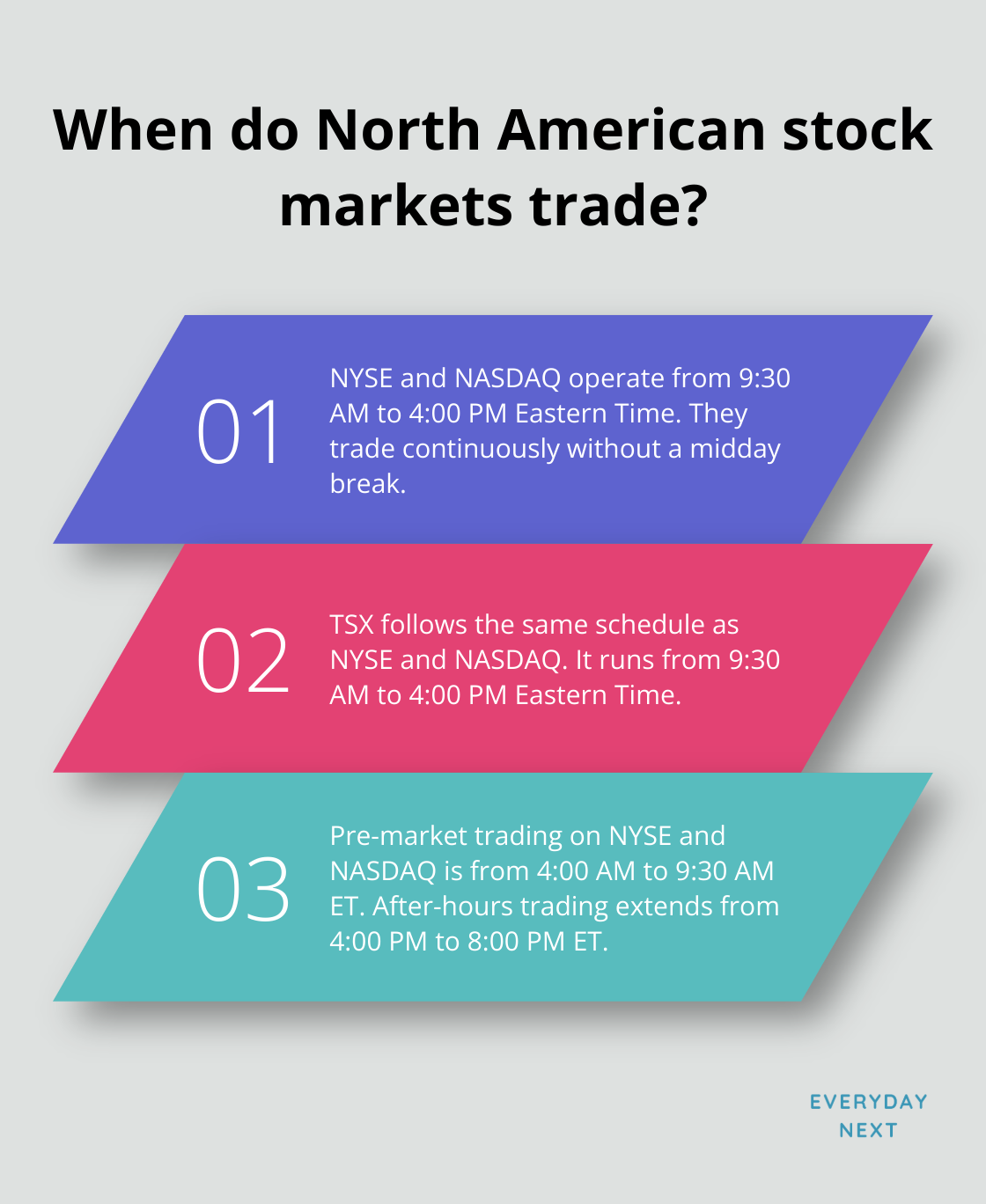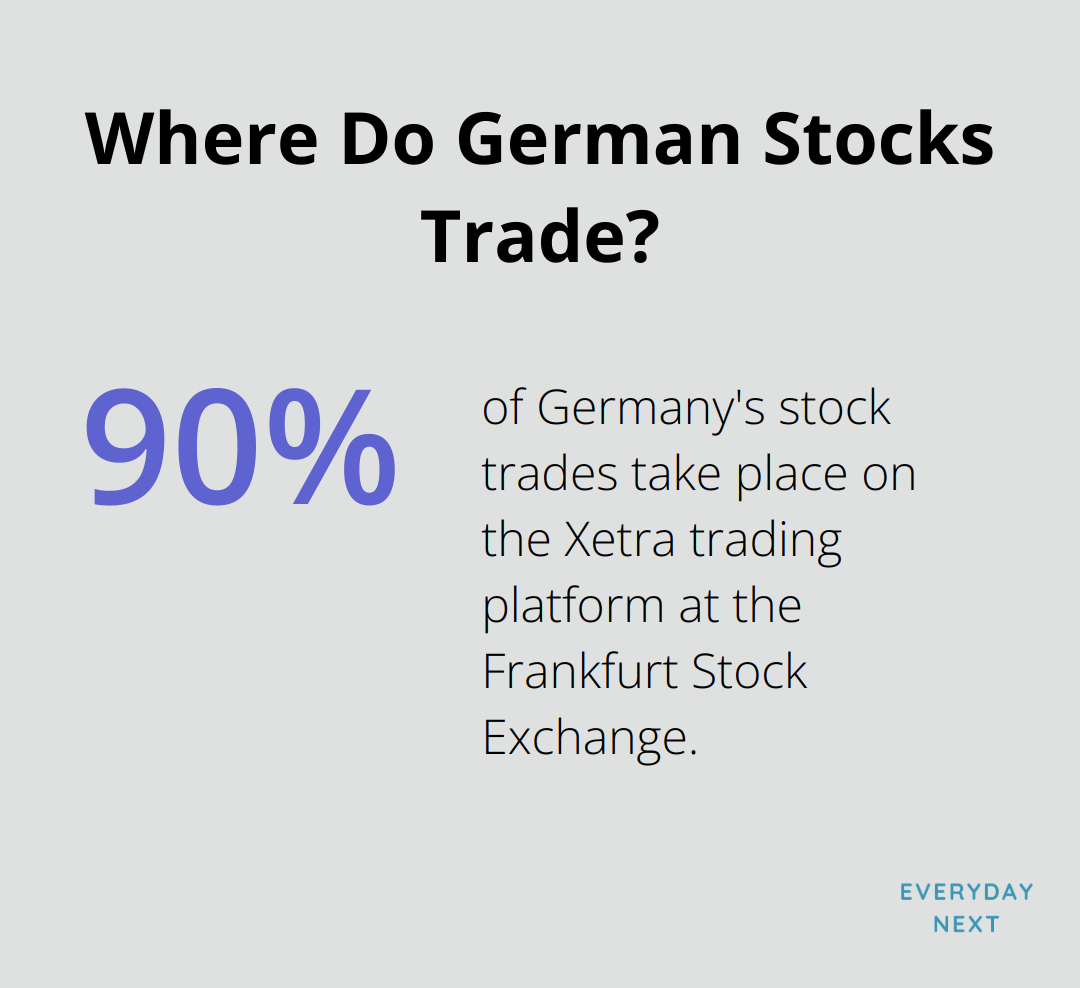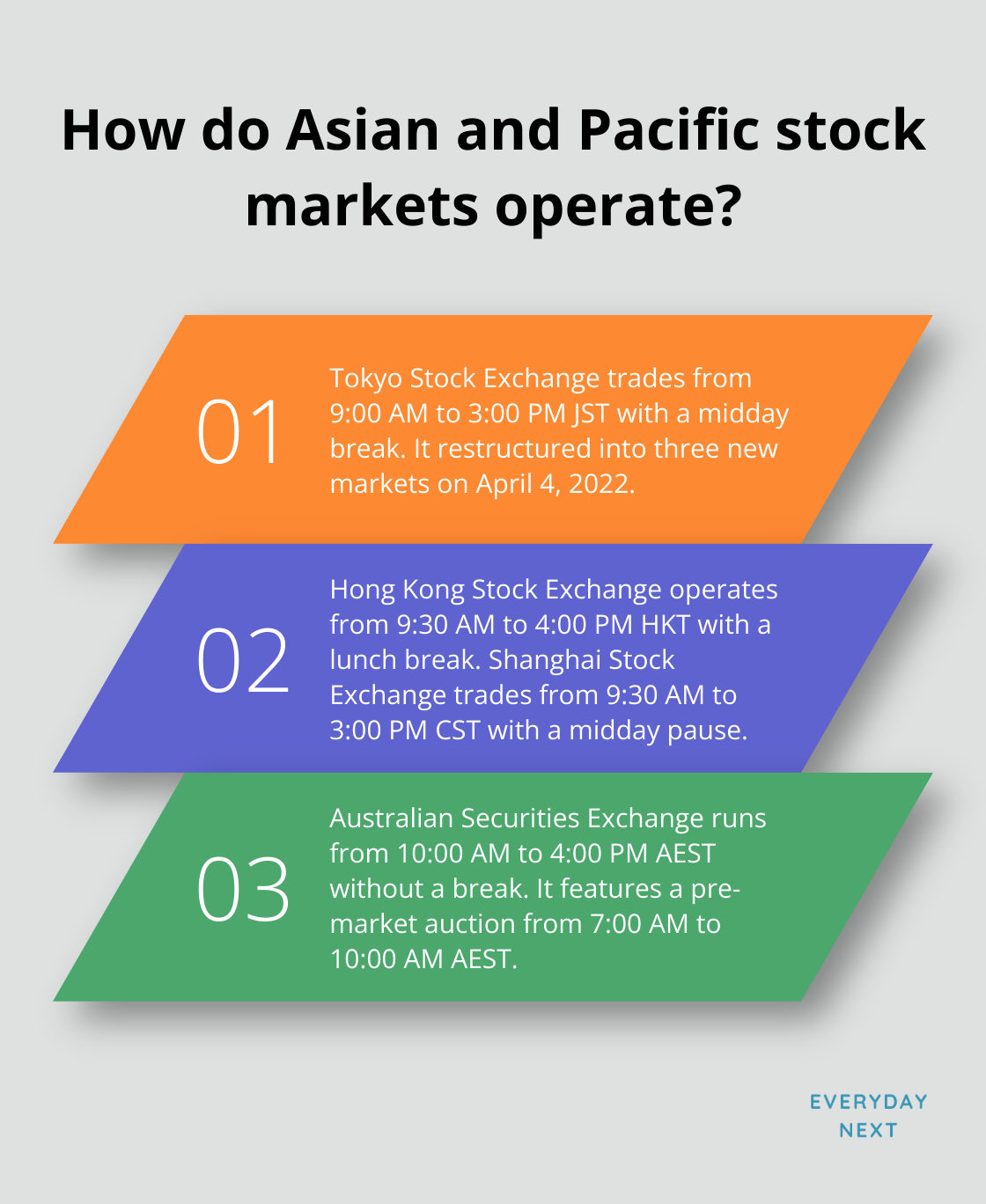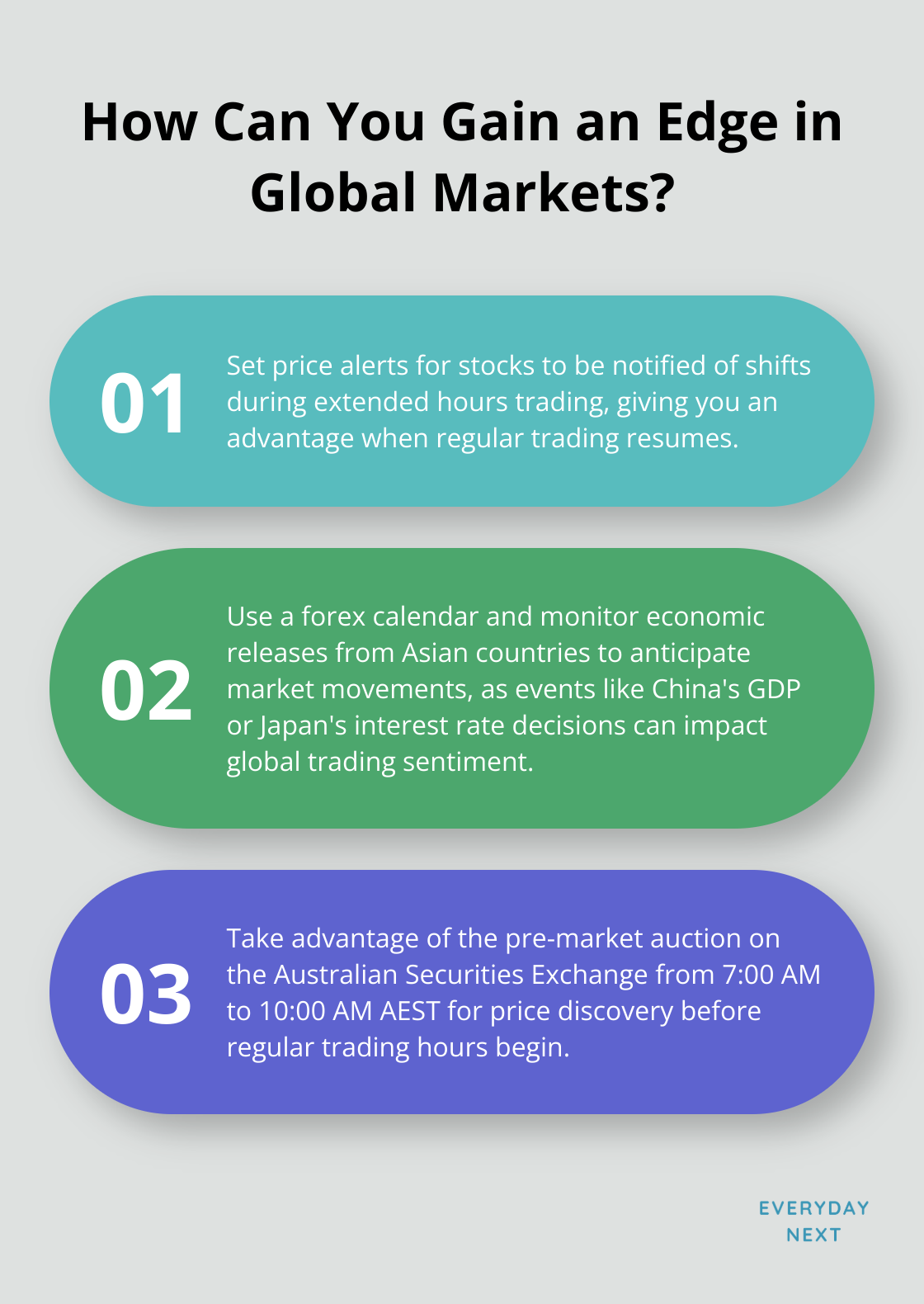
Hours for the World’s Major Stock Markets
So, here’s the deal — figuring out when the stock markets are open is like trying to nail jello to a wall. At Everyday Next, we’ve got the lowdown on this riddled mess. Wondering if you can trade today? Well, that’s the million-dollar question, isn’t it? It’s all about where you are and which slice of the financial pie you’re eyeing.
We’ve got your back — this guide lays out the trading hours for the big players across North America, Europe, Asia, and the Pacific. Let’s demystify extended trading hours and unravel how those pesky time zones turn global market operations into a glorified game of whack-a-mole.
When Do North American Stock Markets Trade?
North American stock markets – the big dogs in global finance. Knowing when they trade? Key intel for investors around the world. Let’s dive into when these financial powerhouses open and close shop.
New York Stock Exchange and NASDAQ
The New York Stock Exchange (NYSE) and NASDAQ – peas in a pod. Both kick off at 9:30 AM and wrap up at 4:00 PM Eastern Time (ET), Monday through Friday. No midday siesta here, unlike some Asian markets – it’s full steam ahead all day long.
Toronto Stock Exchange
The Toronto Stock Exchange (TSX) – twinning with its southern neighbors. Runs from 9:30 AM to 4:00 PM Eastern Time, just like NYSE and NASDAQ. This sync-up lets trading flow smoothly across the U.S.-Canada border.
Extended Hours and Pre-Market Trading
For the early birds and night owls – extended trading hours are your playground. Pre-market on NYSE and NASDAQ? That’s from 4:00 AM to 9:30 AM ET. After-hours linger from 4:00 PM to 8:00 PM ET.

But, tread cautiously… Extended hours can be a rollercoaster – liquidity nosedives, spreads widen, price swings can get wild. Brokers open the gate, but savvy investors? They use limit orders, shielding against unwanted surprises.
Off-hours trading volumes have gone through the roof over the last few years, thanks to pre-market fever. It’s a sign – more folks are jumping into these sessions.
Pro tip: Set those price alerts on your stocks. They’ll ping you when something shifts in extended hours – giving you the upper hand when regular trading resumes.
Nailing down trade timing is about knowing these schedules. Peak market hustle can make or break your strategy and returns, whether you’re into day trading or taking the long view on investments.
Zoom out to European markets, and you’ll see how these trading hours dovetail with North American ones – weaving a global web of financial activity.
When Do European Stock Markets Open?
Alright, let’s break it down – European stock markets … these are the epicenters of global finance. Picture this: their trading hours aren’t just some random timings; they overlap with those in Asia and North America, creating this non-stop flow of trading frenzy. So, let’s dive into the nitty-gritty of the timetables for the big shots in Europe.
London Stock Exchange (LSE)
The LSE – basically Europe’s Wall Street – swings its doors open at 8:00 AM and wraps up at 4:30 PM Greenwich Mean Time (GMT). That’s practically in sync with UK biz hours, a sweet deal for the local trading crowd.

When British Summer Time (BST) kicks in, from the tail end of March to October’s finale, LSE sticks to 8:00 AM to 4:30 PM BST. A heads-up for the globe-trotting traders-this timing tweak means the market overlaps do a little dance.
Frankfurt Stock Exchange (FSE)
Heading over to Germany’s crown jewel, the FSE runs the show from 9:00 AM to 5:30 PM Central European Time (CET) – that’s lining up with 8:00 AM to 4:30 PM GMT, basically mirroring the LSE’s agenda.
Then there’s the Xetra trading platform at FSE (where a whopping 90% of Germany’s stock trades take a spin). It’s got slightly different hours – 9:00 AM to 5:30 PM CET, and then a quick closing auction from 5:30 PM to 5:35 PM.
Euronext Paris
Bring on Euronext Paris, part of the pan-European Euronext exchange. It’s on a similar timetable with Frankfurt, trading from 9:00 AM to 5:30 PM CET (8:00 AM to 4:30 PM GMT).
Euronext’s magic? A unified trading platform from Lisbon to Brussels, clearing the road for trading across countries like a charm. Loads of liquidity, slick market efficiency – it’s the whole package.
Swiss Exchange (SIX)
Onward to Zurich’s SIX – opening at 9:00 AM and closing the shop at 5:30 PM CET (8:00 AM to 4:30 PM GMT). The show runs all day without that midday pause – meaning you’ve got uninterrupted trading action.
SIX isn’t just famous for its solid infrastructure; it’s a whiz at electronic trading, making it a magnet for investors worldwide with its tech-savvy edge.
Cracking these European market hours is a must for global traders. Why? Because when they align with the morning buzz in Asia and the afternoon hustle in North America, you get liquidity peaks and thrilling trading chances.
Consider this: when the LSE kicks off at 8:00 AM GMT, Tokyo’s already into its 4:00 PM action, and Sydney’s catching its 5:00 PM vibe. This overlap? Perfect for quick responses to those Asian market moves. Then there’s New York, blasting into the race at 9:30 AM ET (2:30 PM GMT), just as Europe’s in full throttle – allowing swift info zipping between these finance titans.
But don’t forget the daylight saving tango – it can throw the timing into a temporary spin, altering market overlap durations. Europe and North America shuffle their clocks on different days, making for a brief timing juggle.
These schedules aren’t just slots on a timepiece – they’re the rhythm of global finance, calling the shots on when you can jump into your investment plays. Up next, we’ll turn our gaze to the Asian and Pacific stock markets, connecting the dots for a truly global trading dance floor.
When Do Asian and Pacific Stock Markets Trade
Asian and Pacific stock markets – they set the rhythm for global trading days. We’re talking time zones that are a world apart from their Western counterparts, tossing unique opportunities and, yeah, challenges into the investment game.
Tokyo Stock Exchange Hours
The Tokyo Stock Exchange (TSE) kicks off the Asian trading day. Circle April 4, 2022, on your calendar – the TSE is shaking things up with a restructure into three new markets.

Here’s the kicker: The TSE’s got this midday break, pretty much a unicorn among major global exchanges. It’s a pause for traders to rethink strategies – maybe react to a headline or two. But it also chops down continuous trading time compared to other big players out there.
Hong Kong and Shanghai Stock Exchanges
Now, the Hong Kong Stock Exchange (HKEX) is in action from 9:30 AM to 4:00 PM Hong Kong Time (HKT), with a lunch pause from 12:00 PM to 1:00 PM (1:30 AM to 8:00 AM GMT). There’s this Stock Connect thing – a Mutual Market Access program that lets Mainland China and Hong Kong investors trade on the other market.
Then, the Shanghai Stock Exchange (SSE) chimes in from 9:30 AM to 3:00 PM China Standard Time (CST), again with that midday pause from 11:30 AM to 1:00 PM (1:30 AM to 7:00 AM GMT).
They’re the gatekeepers to Chinese stocks. The HKEX? It’s your ticket into Chinese markets through H-shares and red chips.
Australian Securities Exchange Trading Hours
Take a look at the Australian Securities Exchange (ASX), which runs from 10:00 AM to 4:00 PM Australian Eastern Standard Time (AEST) (12:00 AM to 6:00 AM GMT). It’s doing its own thing – no lunch break here, just non-stop trading.
The ASX rolls out a pre-market auction from 7:00 AM to 10:00 AM AEST. It’s all about price discovery before the main event – a setup that might just shake up the opening prices.
Impact on Global Trading
These hours – they mean everything for global traders. New York calls it a day, and then Sydney’s waking up about an hour later, with Tokyo not far behind – think of it as a near-continuous global trading relay. This overlap? It’s what lets traders quickly react to U.S. market events from across the pond.
Time zone differences – they can be a real beast. So, say you’re in New York, you’d want to be live at 6:30 PM ET to catch Tokyo opening its gates. That’s where algorithmic trading or setting those sneaky limit orders come into play – trading in your sleep, essentially.
A heads-up on daylight saving time switches, folks. Now, Japan and China – no daylight saving, but Australia? They jump on that bandwagon, meaning the market open times might shift by an hour compared to other global markets during certain times of the year.
To tackle trading across these markets, a trusty forex calendar is your best friend – also, keeping an eye on economic releases from these regions. Heavy hitters like China’s GDP or Japan’s interest rate decisions? They’re like little pebbles that can send ripples (or waves) across these markets – and, yes, even tweak global trading sentiment.
Wrapping Up
The global stock market hours? It’s like a tangled web of trading chances stretching across the planet. Each exchange does its own thing in its own time zone, creating this almost non-stop flow of financial frenzy. When different markets overlap, brace yourself-volatility and liquidity get a boost, opening up unique windows for investors to dive in.

And those time zones? Totally crucial for shaping trading strategies. As the markets blink open and shutter close around the world, the info spills out, and price shifts ripple through the global financial machine. One event somewhere can send shockwaves miles away. So, the question, “Is the stock market open today?” becomes a big deal when you’re juggling exchanges across different ticking clocks.
Over at Everyday Next, we’ve got this down. Grasping these market moves is key to nailing those well-informed investments. Knowing global market hours? It’s your ticket for timing trades to perfection and staying ahead of market-shifting events. Today’s financial landscape? It’s global, baby. Opportunities (and yeah, risks) can pop up anytime. So, by keeping a finger on the pulse of market hours and their cross-border antics, you arm yourself to navigate the wild waters of international investing.













